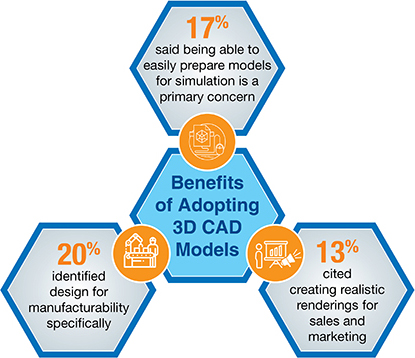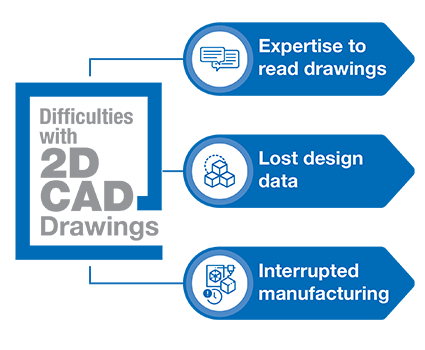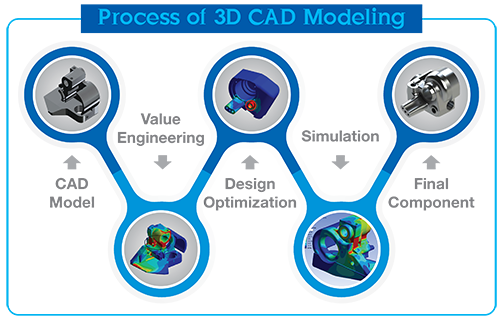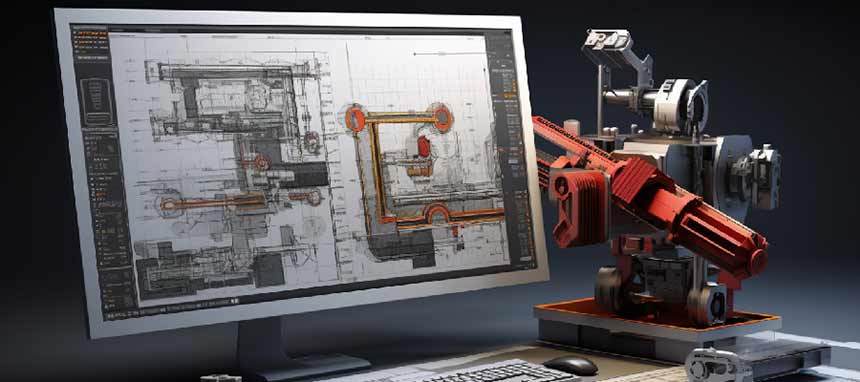
Despite 2D drawings being the first choice for manufacturers, their shortcomings are fast pushing the industry towards 3D CAD modeling. The latter has gained a wider acceptance on the shop floor as well as for design data exchange between various teams and across the enterprise.
Challenges with 2D CAD
- Design intent communication gaps between designers and manufacturers.
- Inaccuracies during data exchange and fear of data loss during file conversion.
- Delayed production due to lack of timely information at production stage.
Recommendations
- 3D models improve design communication and facilitate prototypes for design validation.
- Shifting to 3D CAD can help expedite iterative design procedure by creating single source of truth.
- 3D CAD modeling enables PMI annotations and creates CNC files directly.
Benefits of adopting 3D CAD Models

The advent of CAD changed the outlook of the industry and dramatically improved the productivity of manufactured goods. For example, metal fabricators could achieve higher fabrication accuracy for each small part leading to smooth coordination of parts. This, in turn, resulted in better functioning of complete assembly.
Further, as the technology advanced and NURBS were invented, it paved the way for 3D modeling that included surface, mesh and solid modeling. While there are multiple reasons for the growing acceptance of 3D CAD modeling, comprehensiveness and single source of truth form the primary ones. It can warehouse all the information pertaining to BOMs, PMIs etc. and all the stakeholders can access an update file all the time.
A quick look at limitations of 2D CAD and why 3D CAD became popular
Manufacturing industry has sort of a legacy of 2D drawings. For a long time, they existed as fabrication shop drawings, isometrics of assembly and part drawings, assembly and installation guidelines.
However, there are some fundamental shortcomings of 2D CAD drawings which include:

- Design communication gaps: The biggest drawback of 2D is line representation of every detail across the drawing. Line diagrams are difficult to explain design intent and purpose of every design feature to non-technical teams. These difficulties leave gaps when designs are handed over from one team to another along the hierarchy or at lateral levels.
- Fear of loss of design intelligence: Since 2D CAD files exist in .dwg formats, it becomes a compulsion to translate them into neutral files like DXF or IGES, primarily for manufacturing purposes. However, during the file format conversions, design intelligence is lost as each CAD platform has its own ways of creating and storing the geometry.
- Delayed production activities: The disjointed design communication between design and manufacturing teams using 2D adversely impacts the decision making process at manufacturing stage. It not only lengthens the process but also makes the entire process iterative and hence inaccurate.
When analyzed, all these challenges arise from fragmented design handoffs and inevitable conversions between design and manufacturing engineers. Despite the chronic legacy of 2D drawings in the manufacturing industry, it is time for manufacturers to convert 2D drawings into 3D CAD models for efficiency.
How 3D CAD modeling benefits manufacturers

CAD platforms have fundamentally eradicated drawing sheets and rulers; but more than that, they have offered 3D solid, surface and mesh modeling for product design engineers. They provide a medium to establish an effective design communication channel for designers, manufacturers, sheet metal contractors and sub-contractors, etc.
With 3D CAD modeling, almost all the shortcomings of 2D are eliminated. Direct impacts of 3D CAD modeling includes:
Comprehensive and self-explanatory modeling
Parametric modeling and rendering: Modeling in 3D space offers easy and assisted design visualization which helps other stakeholder to smoothen their integration with product designers. Further 3D geometry also improves internal design reviews and also rendered at times to use them for product marketing.
ATS, Automation Tooling Systems, Inc. (ATS) adopted SolidWorks to transform their legacy design data from 2D to 3D parametric CAD models. With 3D modeling capabilities and animation alternatives the company implemented single design standards. It eliminated drawing errors and structural errors through integrated analysis, uplifted product quality, improved design communication between the teams, and successfully launched a strategic product.
Single source of truth for multi-faceted applications
Vault creation: 3D CAD models when extended to product data management (PDM) will form PDM Vaults referred to as Vaults by Autodesk products. These vault data management software helps design engineer as well as manufacturers to organize, track data development, create and finally validate the designs through simulation thereby streamline activities of the team.
All the files can be saved at one location, accessed any time and replace the design as and when the changes are made to the actual physical products. Vaults essentially store each version of every file and present a history of the product quickly and easily especially for large scale manufacturing firms.
VLI Drilling, a global manufacturer and supplier of equipment and services to coal mining had multiple people working on a single file, stashing them over and again from personal hard drives to FTP server causing chaos. After adopting Autodesk Vault data management system, they were able to organize the files, track changes with accountability and credibility. Number of drawings was reduced, where each revision was done could be saved and located easily.
Proofs of design concepts: These same 3D solid models can also be used a prototypes to obtain proofs of design concepts, design optimization, design analyses and validation of design geometry using CAE tools. Since these virtual tests are non-destructive, they cut a significant amount of costs for validation by replicating real world applications.
ATS, Automation Tooling Systems, Inc. (ATS), a global leader in the design and manufacture of turnkey automated manufacturing and test systems was looking to upgrade from 2D to 3D CAD software for productivity and choose SolidWorks. Its simulation capabilities eliminated structural problems the company had to deal with on shop floor and resulted in optimized productivity.
Easy generation of manufacturing information
A tool manufacturer from the USA, had design legacy of 2D manufacturing drawings in non-editable format which were obstructing documenting design changes. Hitech CAD engineers converted 2D drawing into part and assembly 3D solid CAD models that improved turnaround time on shop floor with comprehensive and easy design communication.
Read Detailed Case Study →
Shop floor needs: When designs are modeled in 3D, the needs of manufacturers – 2D drawings for fabrication, assembly and installation can be extracted easily from these native 3D files. Simultaneously, 3D solid models can also be used to annotate product manufacturing information (PMI) with surface finish, manufacturing methods, etc. over the CAD model – eliminating the very need of file format conversion unlike 2D drafting/drawings.
Model Based Definition: Another option with 3D CAD model is to prepare Model Based Definition (MBD) in SolidWorks which forms a single source of truth about the product design information along with DFM [Design for Manufacturing] features. It gives a comprehensive idea about the product design right from the concept evolution, design development stage, manufacturing, and can be used for final marketing with rendered properties.
A peep into future of 3D CAD modeling
Owing to the valued contributions from various CAD software developers, CAD today is nothing like what it used to be back in the 80s. From 3D modeling techniques to the file formats for data exchange, CAD has come a long way. For instance, there are heavy researches going on for 3D printing and additive manufacturing already.
Few noteworthy trends of the future:
- Rise in design personalization leading automation and better customer experience by integrating CAD with ERP, MES, CRM, PLM, and other support systems.
- Enhancement in collaboration between remotely located manufacturers, designers, and foremen on installation sites through wearables. And further, CAD and Cloud will open opportunities to leverage Augmented Reality, Virtual Reality and Mixed Reality.
- More accurate automation systems as our knowledge in the field of Artificial Intelligence advances. Dream Catcher by Autodesk is an excellent example of regenerative designs.
Conclusion
With these above mentioned benefits of 3D CAD modeling to both, designers and manufacturers, they have been able to raise the quality bar and productivity. It has become possible mainly because of single source of truth for all product design purposes.
Right from delivering better design communication to offering informed decision making during manufacturing stage, 3D solid CAD modeling remains an indispensable part serving multi-faceted applications.


 Feb 28th, 2024
Feb 28th, 2024

Leave a Reply